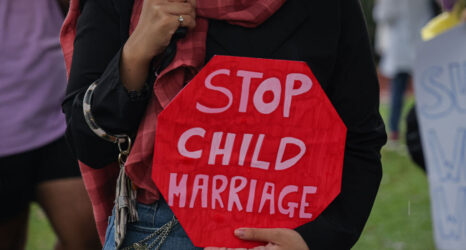Reprinted from the Thomson Reuters Foundation with permission.
This week in London, several hundred advocates and allies, including myself, will join government officials from around the world, led by British Prime Minister David Cameron, to rally a global movement to end female genital mutilation (FGM) and child, early and forced marriage for girls within a generation at Girl Summit 2014. Representing an organization that works to empower women and girls and which, for the past two decades, has raised global awareness about the harms of child marriage and violence against women and girls, I am thrilled to see such high level attention to these important issues that are so critical to international development efforts and to combating inequality.
FGM and child marriage violate the basic human rights of millions of girls worldwide. Not only is FGM an act of violence; it also disempowers girls and women, and can cause significant harm to their health for years to come. And child marriage forces more than 14 million girls every year into a life that restricts their rights and limits their ability to contribute meaningfully to the development of their communities and societies, denying most from continuing their education and cutting their childhoods painfully short.
In addition to being a violation of a girl’s basic human rights, including her right to bodily integrity, FGM has negative implications for her right to a satisfying sex life, as well as her reproductive health rights. Child marriage also has an effect on a girl’s sexual and reproductive health and rights, as it takes away her right to decide if, with whom and when to engage in sexual activity and if or when to have children. Child marriage puts girls at high risk for early pregnancy, sexually transmitted infections and intimate partner violence, among other negative health consequences.
I applaud the U.K. government and UNICEF for bringing these important issues to the forefront of global conversations, and for continuing to mobilize allies from around the world to tackle these challenges faced by millions of girls. The U.K. government also co-hosted a groundbreaking summit on family planning in 2012—which makes it all the more perplexing to see a key missing ingredient from this week’s summit: the broader sexual and reproductive health and rights of adolescents around the world.
And I think girls around the world would agree.
A recent report by the International Center for Research on Women (ICRW) brought the perspectives and priorities of more than 500 adolescent girls from around the world to the global stage. Among the many critical issues raised by the girls was their need to access sexual and reproductive health services, as well as to better understand and be able to act on their sexual and reproductive rights. Simply put, the girls wanted to know their options, how they could use available services, and do so freely and safely.
Whether married or not, adolescents must have access to gender-equitable and rights-based comprehensive sexuality education that enables them to expand their knowledge and their understanding of their bodies, their rights and the services that should be accessible to them. They should have the information and services needed to prevent—and treat when necessary—sexually transmitted infections, including HIV.
And critically, adolescents need access to youth-friendly family planning services, including the information, skills and contraceptive supplies that can help them decide whether, when and how many children to have, not only during their adolescence, but throughout their lives. It’s a tall order, but we know the approaches that can work in making it happen.
ICRW recently published a report that synthesizes the evidence base regarding adolescents and family planning. Specifically, we looked at the barriers to adolescents’ access to, and use of, family planning services, programmatic approaches for increasing access and uptake of those services, gaps in the evidence that require further research, and areas that are ripe for further investment. In short, the report looks at the “demand” and the “supply” side of family planning, identifying barriers and ways to overcome those barriers in order to help adolescents effectively use family planning methods to reach their reproductive desires over their life course.
The issues are complicated and, like so many other challenges in global development, there is no simple solution. But there is enough evidence to act. And there is enough evidence to demonstrate that we must invest further in meeting the full range of sexual and reproductive health and rights needs of adolescents if we are to succeed in our goal of helping adolescents grow into healthy, productive and empowered citizens. Talking about these issues, particularly when we talk about adolescent girls, would at least be a start.
Dr. Suzanne Petroni is Senior Director of Gender, Population and Development at the International Center for Research on Women.
Photo courtesy of Flickr user Brian Stacey licensed under Creative Commons 2.0





